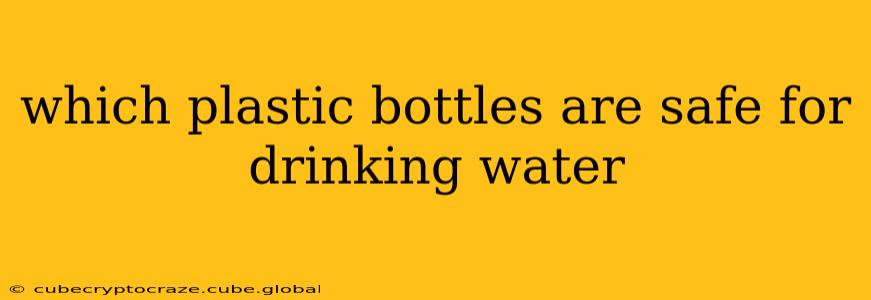Choosing the right plastic bottle for drinking water is crucial for your health and the environment. Not all plastics are created equal, and some can leach harmful chemicals into your water, especially when exposed to heat or repeated use. This guide will help you navigate the world of plastic bottles and identify those that are generally considered safe for drinking water.
What Makes a Plastic Bottle Safe for Water?
The safety of a plastic bottle for drinking water primarily depends on the type of plastic it's made from. This is indicated by a recycling code, usually a number inside a chasing arrows symbol on the bottom of the bottle. Not all numbers indicate safety, and even within a number, there can be variations in safety. Let's look at some of the common types:
1. PET or PETE (Polyethylene Terephthalate) - #1:
This is the most common type of plastic used for single-use water bottles. While generally considered safe for single use, repeated use or exposure to high temperatures can cause leaching of chemicals. Therefore, it's best to avoid refilling PET bottles.
2. HDPE (High-Density Polyethylene) - #2:
HDPE is a relatively safe and durable plastic. It's less likely to leach chemicals than PET and is often reused for storing things like milk or cleaning products. It's generally considered safe for repeated use, making it a better choice for reusable water bottles.
3. PVC (Polyvinyl Chloride) - #3:
PVC is generally not recommended for water bottles. It can contain phthalates and other potentially harmful chemicals that can leach into your water.
4. LDPE (Low-Density Polyethylene) - #4:
LDPE is a flexible plastic often used for squeezable bottles and plastic bags. It's generally considered safe for food contact, but again, repeated use and high temperatures can be a concern.
5. PP (Polypropylene) - #5:
PP is a relatively safe and durable plastic, often used for reusable water bottles and food containers. It's generally considered safe for repeated use and can withstand higher temperatures than PET.
6. PS (Polystyrene) - #6:
PS is often used for disposable cups and plates. It's not recommended for water bottles due to the potential for leaching styrene, a chemical that may have harmful effects.
7. Other - #7:
This category includes a variety of plastics that are not easily categorized. It's best to avoid bottles labeled with #7.
What About BPA-Free Plastics?
Bisphenol A (BPA) is a chemical used in some plastics that has been linked to various health concerns. Many manufacturers now offer "BPA-free" products. While this is a step in the right direction, it's important to note that BPA-free doesn't necessarily mean completely safe. Other chemicals may be used as replacements, and their long-term effects are not always fully understood.
How to Choose the Safest Plastic Water Bottle?
- Look for the recycling code: Focus on HDPE (#2) or PP (#5) for reusable bottles.
- Choose reputable brands: Reputable brands often undergo stricter testing and quality control.
- Avoid repeated use of PET (#1) bottles: Use them once and recycle them properly.
- Avoid bottles with #3, #6, or #7: These are generally not recommended for water bottles.
- Check for independent certifications: Some organizations test and certify plastics for safety.
- Inspect the bottle regularly: Discard any bottles that show signs of damage or wear.
Are Glass or Stainless Steel Better Alternatives?
Yes, glass and stainless steel are excellent alternatives to plastic water bottles. They are generally considered safer, more durable, and environmentally friendly.
How Can I Tell if My Plastic Water Bottle Is Leaking Chemicals?
Unfortunately, there's no easy way to tell if your plastic water bottle is leaching chemicals without specialized testing. However, paying attention to the recycling code, avoiding repeated use of questionable plastics, and choosing reputable brands can minimize the risk. If you notice any unusual smells or tastes from your water bottle, it's best to discard it.
Is it safe to reuse plastic water bottles?
While some plastics like HDPE (#2) and PP (#5) are generally considered safe for reuse, it is always advisable to inspect your bottles regularly for signs of wear and tear and to replace them when necessary. Avoid reusing bottles made of PET (#1), PVC (#3), or PS (#6).
This information is for general guidance only and should not be considered medical or scientific advice. Always consult with a qualified professional for any health concerns.
